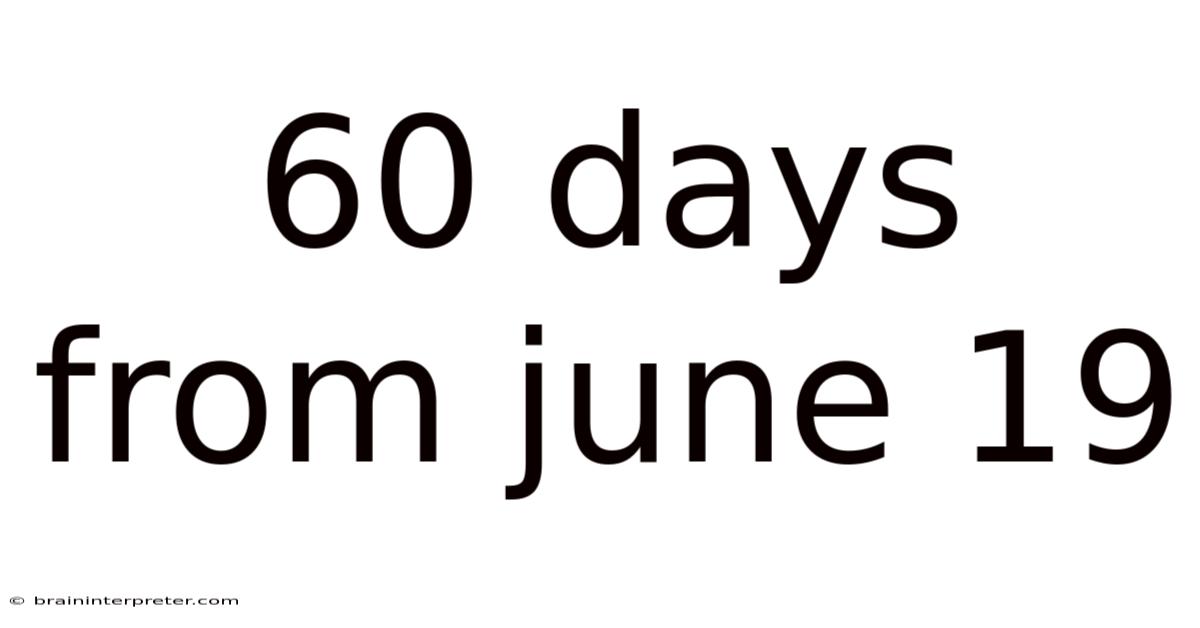60 Days From June 19
braininterpreter
Sep 16, 2025 · 4 min read

Table of Contents
60 Days from June 19th: A Journey Through Time
Counting 60 days from a specific date might seem simple, but understanding the implications of this calculation – particularly across months and potential calendar variations – reveals a fascinating interplay of mathematics and timekeeping. This article will delve into precisely calculating the date 60 days after June 19th, explore the concepts behind calendar calculations, and offer a broader understanding of temporal reckoning. We'll even look at some interesting historical events that might have occurred during a 60-day period starting on a similar date.
Understanding the Calculation: A Simple Approach
The most straightforward approach is to add 60 days to June 19th. We can break this down into manageable chunks. June has 30 days, so adding 11 days (30 - 19) takes us to the end of June. This leaves us with 49 days remaining (60 - 11). July has 31 days. Subtracting 31 from 49 leaves 18 days. Therefore, 60 days after June 19th is August 18th.
A More Robust Approach: Considering Leap Years and Calendar Systems
While the above method works for most cases, it's crucial to consider the complexities of the Gregorian calendar. A leap year, which occurs every four years (with exceptions for century years not divisible by 400), adds an extra day (February 29th). This seemingly small detail can significantly affect calculations spanning several months. Our calculation above assumes a non-leap year.
For a more robust calculation, particularly for larger time spans or programming applications, one might use a date/time library or algorithm. These tools account for leap years and other calendar intricacies automatically. However, for a simple calculation like 60 days, the manual approach is perfectly adequate as long as the leap year is considered.
The Significance of 60 Days: Timeframes and Applications
A 60-day period holds significance in various contexts:
-
Business and Finance: Many business processes, financial reports, and investment strategies utilize 60-day (or two-month) intervals for analysis and forecasting. This timeframe offers a balance between short-term and long-term perspectives.
-
Project Management: Project timelines frequently incorporate 60-day milestones for tracking progress, identifying potential delays, and adapting strategies.
-
Legal and Administrative Procedures: Certain legal proceedings, contractual obligations, and administrative processes have deadlines or review periods spanning 60 days.
-
Personal Planning: Individuals might use 60-day periods for goal setting, saving targets, fitness challenges, or other personal development initiatives.
Beyond the Calculation: Exploring Temporal Concepts
The simple act of calculating 60 days from June 19th opens the door to broader considerations of time itself:
-
The Subjectivity of Time: While we use precise systems to measure time, our personal perception of 60 days can vary widely depending on context and experiences. A 60-day period filled with exciting events may feel shorter than a 60-day period characterized by monotony.
-
Historical Context: Examining events that occurred within a 60-day period starting around June 19th in different years provides a fascinating lens through which to study history. The impact of these events – whether significant global occurrences or personal milestones – underscores the importance of context in understanding time's passage.
-
Time's Linearity vs. Cyclicity: Our calculations assume a linear progression of time. However, many cultures incorporate cyclical perspectives on time, viewing it as a recurring pattern rather than a unidirectional flow.
Frequently Asked Questions (FAQ)
-
What is the date 60 days after June 19th in a leap year? The calculation remains the same unless the leap year falls within the 60-day period (affecting February). If the leap year is involved and includes February 29th within the 60-day span, the resulting date would be August 19th.
-
How can I calculate this for any date? You can use the same method described above: determine the remaining days in the starting month, subtract that from 60, and continue adding days from subsequent months until the 60-day total is reached. However, for larger calculations or programming applications, using a date/time library is highly recommended.
-
Are there any calendar systems that differ significantly from the Gregorian calendar, impacting this calculation? Yes, the Julian calendar, a predecessor to the Gregorian calendar, differs in its leap year rules. Other calendar systems, like the lunar calendar or various cultural calendars, have entirely different structures, making direct comparisons complex.
-
What programming languages or tools can help with date calculations? Most programming languages (Python, Java, JavaScript, etc.) have built-in libraries or modules specifically designed for handling dates and times. Spreadsheet software also provides functions for date calculations.
Conclusion: More Than Just a Calculation
Calculating 60 days from June 19th is more than a simple mathematical exercise. It's a journey into the fascinating world of temporal reckoning, highlighting the intricacies of our calendar systems, the subjective nature of time perception, and the rich historical context woven into each passing day. By understanding the underlying principles and employing the appropriate tools, we can accurately determine future dates and gain a deeper appreciation for the flow of time itself. The seemingly mundane act of adding 60 days to a specific date opens up a world of possibilities for analysis, planning, and historical exploration. Remember to always consider leap years for accurate results across longer time spans.
Latest Posts
Latest Posts
-
120kg Is How Many Pounds
Sep 16, 2025
-
How Much Is 15 Feet
Sep 16, 2025
-
650 Ml To Fl Oz
Sep 16, 2025
-
How Tall Is 1 78 Meters
Sep 16, 2025
-
Convert 27 Inches To Cm
Sep 16, 2025
Related Post
Thank you for visiting our website which covers about 60 Days From June 19 . We hope the information provided has been useful to you. Feel free to contact us if you have any questions or need further assistance. See you next time and don't miss to bookmark.